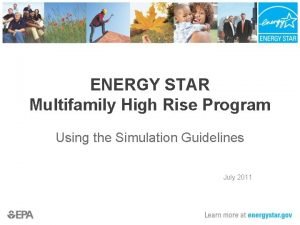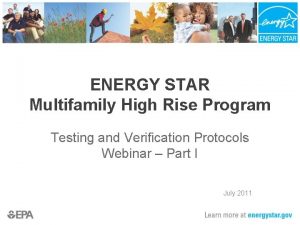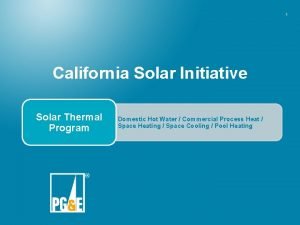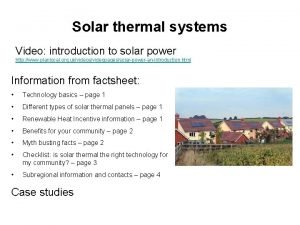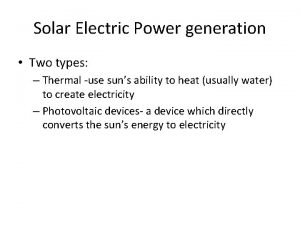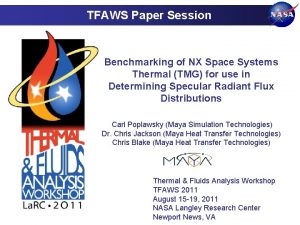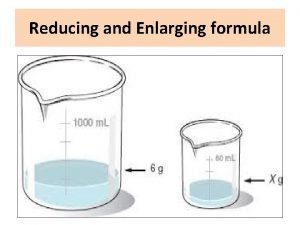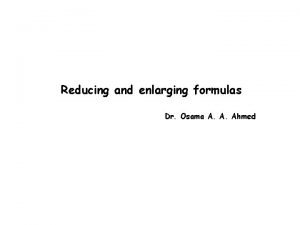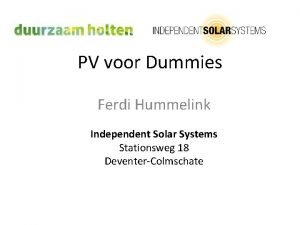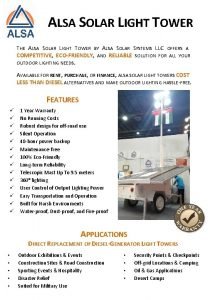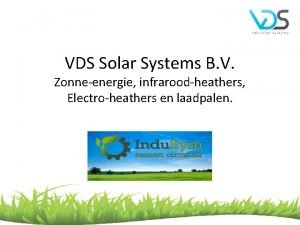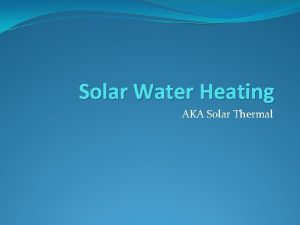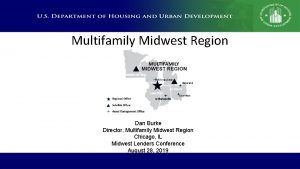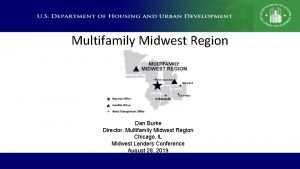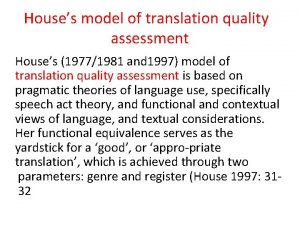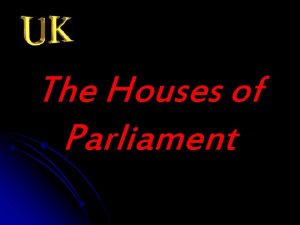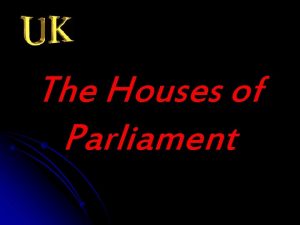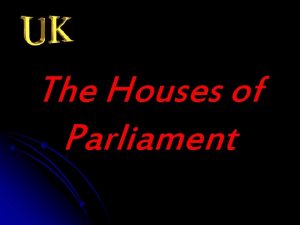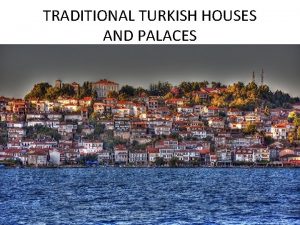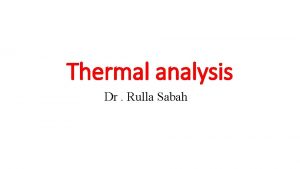SOLARGE ENLARGING SOLAR THERMAL SYSTEMS IN MULTIFAMILY HOUSES

























- Slides: 25

SOLARGE: ENLARGING SOLAR THERMAL SYSTEMS IN MULTI-FAMILY HOUSES, HOTELS, PUBLIC AND SOCIAL BUILDINGS IN EUROPE - SOUND SYSTEM SOLUTIONS FOR MULTI-FAMILY HOUSES - CIERTA 2006, Almeria, 7 October 2006 Ronald Voskens Ecofys S. L. r. voskens@ecofys. com tel. +34 93 3909075

Index • Introduction • SOLARGE • Market MFH • Typology • Conclusions, Recommendations • To conclude

Econcern Palm towers, Netherlands The sustainable energy solution provider CO 2 neutral offices Murcia, Spain 14 MW PV plant Wave rotor Scira, UK 315 MW offshore wind farm The sustainable energy knowledge and innovation company The sustainable energy system supplier The sustainable energy project developer The sustainable energy innovation entrepreneur

Econcern Offices • 2 offices en Canada • Office en China • Spain: • Ecofys/Ecostream – Barcelona – Madrid – Sevilla – Murcia • > 450 personas

SOLARGE project (1/3) • SOLARGE; – Enlarging Solar Thermal Systems in Multi-Family-Houses, Public and Social Buildings in Europe • January 2005 – December 2007 • 7 countries: Germany, France, Netherlands, Italy, Denmark, Slovenia, Spain • 11 partners: in Spain Ecofys with support of Ecostream • www. solarge. org

SOLARGE: objectives (2/3) • SOLARGE is a European co-operation project to open up markets for large solar thermal plants, (>30 m 2) for multi-family buildings (MFH), hotels, public and social buildings – Analysis of existing projects and identification of market obstacles and opportunities – Identifying factors for success concerning technology, project development and realisation – Information and sensitisation of target groups in Europe – Compilation and communication of European good practice projects and solutions – Support for national and European energy policies – Development of proposals to improve existing political framework conditions for CSTS applications – Europe-wide dissemination of results

SOLARGE: realisation (3/3) • Training and further education measures for the supply side e. g. manufacturers and architects • Events concerning the above subjects in the partner countries • Compilation of well-documented best practice projects • Interviews with plant operators, manufacturers and investors • Information campaign for investors • Support for municipalities and decision makers • Positioning the issue at events and conferences • Provision of information material via internet • EU-wide dissemination of the project results: interactive project web-site, market studies, good practice project database: see www. solarge. org

MFH Market • Total market 30 mlj. dwellings • 40% of the total dwellings • New production – Spain – France 400. 000 130. 000

MFH Solar thermal Market • 645 MWth total annual market – 12% total installed – 375 GWh – 163 Mton CO 2 • 350 MWth Spain • 150 MWth France

CTE HE-4: Minimum solar contribution hot water preparation • 5 climate zones • If hot water consumption >50 l/day

Solar powered hot water system 1 2 3 4 5 6 7 8 9

Basic system configurations *De-central on dwelling level *Central on string or building level

System analyses • Technical issues – Suitability – System performance – Heat losses – Complexity & reliability • Non-technical issues – Investment costs – Exploitation & invoicing – Maintenance

Type: DDD (1/6) • Single family and multi -family houses – Advantages: • Individual systems – Disadvantages: • Limited storeys • Heat losses • Multiple components

Type: CCC (2/6) • Central system for hotels, MFH, etc) – Advantages: • Simple and cheap • Small heat losses tank – Disadvantages: • High heat losses recirculation pipes • Exploitation and maintenance

Type: CCD (3/6) • Semi central system for MFH – Advantages: • Simple and cheap • Small heat losses tank – Disadvantages: • High heat losses recirculation pipes, les than CCC • Exploitation and maintenance

Type: CDD. 1 (4/6) • Semi de-central system for MFH; parallel – Advantages: • Small heat losses pipes • No additional invoicing – Disadvantages: • 1 control • Complicated hydraulic system, adjustments

Type: CDD. 2 (5/6) • Semi de-central system for MFH; parallel – Advantages: • Small heat losses pipes • No additional invoicing • Optimal use collector – Disadvantages: • Multiple components • More expensive

Type: CDD. 3 (6/6) • Semi de-central system for MFH; series – Advantages: • Small heat losses pipes • No additional invoicing • Simple hydraulic system • Less expensive – Disadvantages: • Solar heat exchange between dwellings

Conclusion and recommendations • Solar thermal systems for MFH sector is a promising target market (350 k. Wth ~0, 9 million m 2 per year) • Spain and France represent 55% of this market • Lots of system configuration are applied in this market, with all have advantages and disadvantages • Bottom line: apply sound solutions that last for > 20 years without technical problems and a minimum of maintenance • How? Apply simple and solid configurations, meaning: – As few as possible (moving) parts – Avoid complex hydraulic solutions • Do they exist? …. Yes!

To conclude New generation solar thermal system ICS: Integrated collector storage

Principle (1/2) transversal section

Principle (2/2) longitudinal section

Advantages • Collector and tank (stainless steel) one and the same component • No space required inside dwelling • Better costs/benefits balance • Easy to install, no maintenance • No pump, no pump control, no additional pump energy, no heat exchanger • No anti-freeze liquids required • Double protection against overheating and freezing • Applicable in single and multi family houses (in different configurations)

Thank you for your attention! • And lets develop the MFH market in a sustainable and sound way Ronald Voskens Ecofys S. L. www. ecofys. es r. voskens@ecofys. com tel. +34 93 3909075 See also: www. solarge. org www. ecostream. es
 Solar on multifamily affordable housing
Solar on multifamily affordable housing Solar on multifamily affordable housing
Solar on multifamily affordable housing Accepting houses
Accepting houses Multifamily radon testing
Multifamily radon testing Rural multifamily housing
Rural multifamily housing Energy star multifamily high rise
Energy star multifamily high rise Energy star multifamily
Energy star multifamily Cbre chicago multifamily
Cbre chicago multifamily Section 3 using thermal energy worksheet answer key
Section 3 using thermal energy worksheet answer key Thermal transfer vs direct thermal printing
Thermal transfer vs direct thermal printing California solar initiative thermal program
California solar initiative thermal program Solar thermal
Solar thermal Solar thermal
Solar thermal Solar thermal
Solar thermal Wholesale solar cells
Wholesale solar cells Solar energy is free. solar is inexhaustible
Solar energy is free. solar is inexhaustible Nx space systems thermal
Nx space systems thermal Broadening the pie
Broadening the pie Enlarging formula
Enlarging formula Factor method in reducing and enlarging formula
Factor method in reducing and enlarging formula Enlarging and reducing formula
Enlarging and reducing formula Reducing and enlarging formulas pdf
Reducing and enlarging formulas pdf Independent solar systems
Independent solar systems Alsa solar systems llc
Alsa solar systems llc Vds solar
Vds solar Decision support systems and intelligent systems
Decision support systems and intelligent systems





